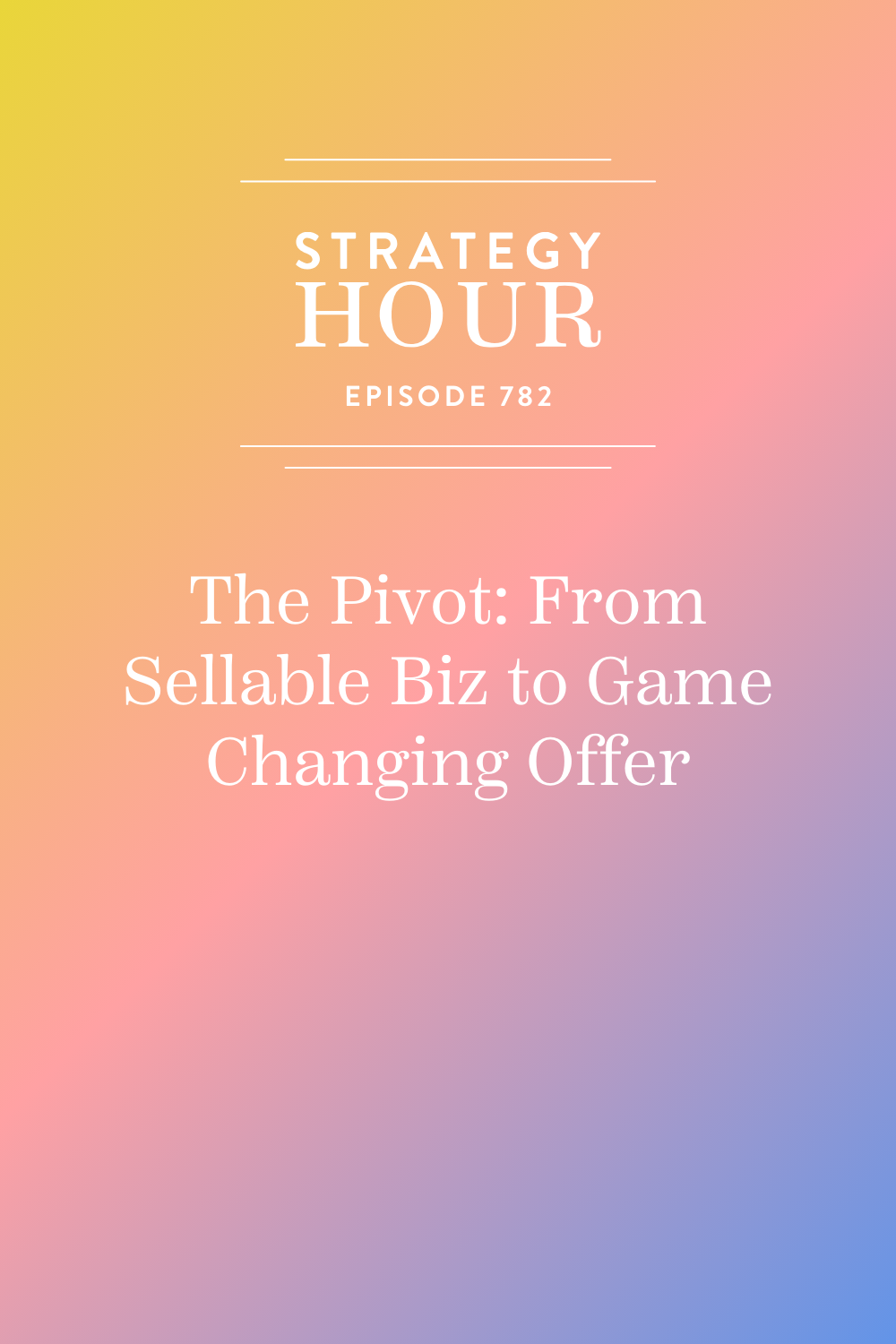The Pivot: From Sellable Biz to Game-Changing Offer
Episode 782: Show Notes
Lately, I’ve shared a lot of the behind-the-scenes of my marketing and messaging pivot that has happened within my business but what I haven’t shared are the changes to my actual offer. This was not a small decision because I undid three and a half years of work to make my business more sellable and focused on what would give my clients better results. Today, I am going to share all of the changes I made in my business over the last three years. In order to give you the full behind-the-scenes, I need to back up quite a bit. I desperately wanted a product shop from 2016 and it was so far removed from the kind of business I was running. As time has passed, I have become more and more aware of the challenges associated with running one so I began to think about a digital shop. I saw a hole in the market for tools that help business owners enhance their client experience, present themselves more professionally, and speed up their sales process.
In January 2020, I launched the Creative Template Shop. I wanted to have everything available up front but I didn’t necessarily only want to sell these things once off. I wanted recurring revenue and that was only possible with some sort of membership option. This worked so well and was so focused on the product itself which allowed it to be removed from Boss Project. To make this viable we really had to lock in on the process and we managed to! We used the audience we already had to create warm traffic and present the Creative Template Shop to them. We also used paid advertising early on to focus on cold leads. We presented the products as individual things that could be purchased but as soon as the website was clicked on, it was very clear that becoming a member would be so much more worthwhile and as a result, very few people bought one-off templates. And then everything changed.
The Numbers Game in Subscription Based Business
When you know exactly what you’re selling it becomes a numbers game whereby you specifically focus on a handful of metrics to scale an offer of this type. Acquisition costs refers to how many dollars it takes to acquire a client and how much that is in comparison to the lifetime value of money that the client can potentially bring in. Our acquisition cost for the Creative Template Shop led us to a 5.8x return but the problem was it was taking us two months to break even and to earn the client’s lifetime value, it took eight months of membership. All of this would be great if they were the only variables we needed to consider but the part that you battle when trying to scale a product like this is churn. Churn refers to the number of paid subscribers who are leaving on a regular basis.
Any subscription-based product battles churn and getting churn down is the fastest way to improve the lifetime value of your customer. So, to make more money, you either have to drive acquisition costs down or reduce churn to increase the number of dollars you are keeping in the lifetime value. The thing that a lot of people don’t consider when selling a product like mine is that if you do not grow faster than churn, you’ll start shrinking once you’ve moved through your warm market. So unless you can sell more than those you lose, your membership numbers are going to stay the same or shrink. This balancing act can be incredibly exhausting and the Creative Template Shop eventually hit this ceiling too.
The Two Kinds of Metrics You Need to Focus On
When all the new privacy laws got rolled out I struggled a little bit. The Creative Template Shop could not grow organically without paid advertising. So I decided to change the focus by turning ads off so that I could get some more clarity in the market. I got to the point where the membership was the highest form of revenue in the business but because of the cost of acquisition, it was the lowest profit earned based on the amount of revenue it was generating. It was a scalable cash-eating machine! At that point, the group program was showing so much promise and I was excited to lean into that so I put far less emphasis on the membership internally. I focused on maintaining it instead of growing it. 2022 was Boss Project’s biggest year ever in terms of top-line revenue and the membership went from being 50% of that revenue to just 24% because other things were outperforming what the membership was doing.
The One Thing You Need to Know About Getting More Leads
The more one-to-many that you’re selling, the more traffic is required for it to work. The group program was working so well because of the method of sales and because I was so specific about the leads I was targeting. But at that same time, the leads were going down. It’s easy to assume that I just needed more leads and while that’s true, you can only get more leads if you have enough traffic that contains qualified people. There are loads of strategies to get more qualified traffic like ads, doing more things to increase discoverability, targeting traffic through paid advertising, cold outreach, and referrals. But what getting more qualified traffic comes down to is either attracting it or creating it.
Creating qualified traffic entails taking the traffic that you already have and doing the things necessary to create the qualifications. I wanted to develop an ecosystem where I could help people at every stage of business because there are so many problems that people face at various points along that journey. I had been so focused on the later-stage problems that I wasn’t focused on helping people at those earlier stages which meant that I wasn’t creating more qualified traffic. With my mission in mind and my focus being on impact not money, I needed to reimagine how I could help.
Pivoting Back to My Mission
Sure, keeping the Co-op as it was would’ve definitely made the business more sellable. But I am at the stage of my business where I can take more risks and my focus is on impact and not cash flow so I wanted to deliver the highest impact at the most reasonable and approachable price point. I had great results with my one-on-one clients but the problem with that approach is that I can only get one result at a time. The prices are also extremely high meaning that it is targeted at established and successful businesses. Instead, I decided to figure out what small business owners need to know to get to that point. In the last three years, I have done a lot to increase the overall lifetime value and reduce the churn of my business but the things I have done even as recently as the last 30 days have had a dramatic effect on both of those numbers.
It was an incredibly big decision to make these changes and it took me six months to make, but it also gave me so much clarity on the fact that I do not need my business to be sellable in order to retire early. I realized that it’s far more beneficial for me to continue to run my business until I am ready to retire without selling it. I have felt a lot of pressure in the past to make certain decisions about the business simply to be able to sell it in five to 10 years and recently, I undid a lot of those decisions. I will definitely be thinking about a succession plan for Boss Project but at this point, it doesn’t have to require selling the business. With my focus being on impact, it’s far more important to me to serve small business owners than to make decisions based on a potential future sale.
What Does This Mean for You?
Some of you may want to rethink the long-term goals of your business! Now, I’m not suggesting that you make the same decisions I did. Instead, I want you to reflect on solving the burning problems for your clients and changing your focus to creating true, game-changing solutions. When your success rate goes up, all of the parts of your business work better. I don’t want you to change everything about your offer but there are small tweaks you may be able to make to your existing offer to better solve the whole problem your clients are facing. If you feel like this is too much, try to focus on a smaller aspect. This means a whole lot less over-promising on your part! Client success can make such a huge difference and when you are confident that you can speak to that, that is a sales tool that you cannot manufacture. When you are confident in discussing your offer, people pay attention!
I have had a few hiccups and have finally gotten to the point where I am so proud of the services I provide. In a period of three years, we went from being focused on the membership, to spending 18 months on the group program, then going back to the membership and changing the offer significantly! And I am still in development mode! I am fully confident that this massive pivot was the right decision for me, my business, and my mission. If this means that I make less money then that is okay if I am able to see more small business owners be financially free. I want you to be a part of this regardless of where you are at in your business! I want to provide you with the tools and strategies needed to scale your business and live the life you want to live. I know that the Co-op is different from everything else in the market. If you’re interested in all of the behind-the-scenes details then go watch the Untitled training, join the Co-op, follow me on Instagram, and feel free to send me a DM anytime!
Quote This
More scalable to you does not necessarily equal more sellable to someone else.
Highlights
The Numbers Game in Subscription-Based Business. [0:10:13]
The Two Kinds of Metrics You Need to Focus On. [0:18:48]
The One Thing You Need to Know About Getting More Leads. [0:24:15]
Pivoting Back to My Mission. [0:32:22]
What Does This Mean for You? [0:45:28]
OUR HOST:
Abagail Pumphrey
Boss Project on Instagram | Facebook
Abagail Pumphrey, the Co-Founder & CEO of Boss Project, has been a driving force in the creative entrepreneur industry since 2015. With a passion for empowering service-based business owners around the globe, she became internet-famous after the launch of the transformative training, "Trello for Business." This innovative system revitalized the operations of over 10,000 business owners, making a significant impact on the online business landscape.
Under Abagail's leadership, Boss Project has been featured in prestigious publications such as Forbes, Marie Claire, INC, and HuffPost. Her twice-weekly podcast, The Strategy Hour, is a staple in the business community, continuously topping Business and Management Charts on Apple with millions of listeners from around the world.
Abagail's superpower lies in her ability to break down complex concepts into easy-to-implement, duplicatable systems. As an expert in online sales and a data-driven strategist, she has turned a layoff into a 7-figure work-from-home business. Abagail's mission to help more female founders become financially free, without letting their businesses take over their lives, continues to inspire and guide entrepreneurs on their path to success.
Key Topics:
Sellable Business, Acquisition and Churn, Digital Product Shop, Mission-Focused Business




